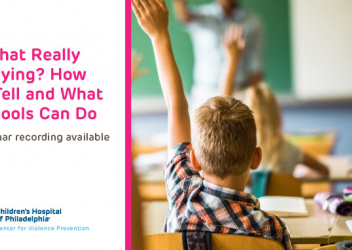Research In Action
Research In Action
Breadcrumb

In a previous blog post, and a recently published CHOP Health Tip, we discussed our experience with using a quality improvement framework to address bullying related to children on the autism spectrum. Children with ASD are bullied at higher rates than other children and due to their social skills differences, may have a harder time knowing how to respond. This makes it vital for adults to support them and guide them in handling bullying situations. In today’s post, we’d like to offer some high-quality resources to address bullying in this population that providers can share with families.
School-Based Resources
First, parents should know that adult intervention is always needed. Parents should reach out to school leaders and keep the child's team informed and involved when their child experiences bullying. Together, the parents and school can partner to create a safety plan for the child. Goals related to bullying or teasing can be added to the child’s Individualized Education Program (IEP). A sample IEP goal might be: “Identify and practice direct and indirect ways to react to, handle, and lessen the effects of bullying behavior.” Additionally, parents can request supplementary aids and services, and program modifications or supports, such as:
- Hallway or playground monitoring by school staff
- Allowing the child to leave class early to avoid hallway incidents
- Using social stories to help child understand difficult situations when they occur
- Setting up a no-questions-asked procedure for the child to remove him or herself from a situation where bullying behavior occurs
Parents may even consider working for change at their child's school by advocating for in-service education for school staff and classroom peers to explain a child’s disability and vulnerability to bullying, as well as positive bystander training for classmates.
Beyond School Support
When the school is not responding appropriately to bullying reports, parents can write a letter reminding school administrators of their legal obligation to provide a Free and Appropriate Education for their child. In addition, bullying a child with an IEP can be considered harassment, which is a crime. If the parents desire to seek support beyond the school, they can reach out to their state’s department of education or Office of Civil Rights. In Pennsylvania, parents can call the Pennsylvania Department of Education Bullying Prevention Consultation Line for advice at (866) 716-0424.
Working With the Child
A priority goal is making sure the child knows that being a target of bullying is never his or her fault. And then, even though getting bullied is not a child's fault, it is important to learn ways of handling bullying and teasing in the moment. Strategies to teach the skills to cope include:
- Understanding what bullying is and what it is not. Children should learn to adjust their responses according to the severity of what is happening and to know what to do when another child is bothering them versus bullying them.
- Honing general self-advocacy skills. This will build a child’s confidence across the board! Script some phrases a child can use to speak up assertively. For example: “Hey, stop. Leave me alone;” “Everyone's mind works a little differently;” “I just get overwhelmed, but I'm working on it;” “These kinds of things take more time for me to figure out.”
- Practicing the words a child can use to get help from an adult.
Bullying can be a traumatic experience for children and their families. Empowering parents with the knowledge of next steps to proactively address bullying concerns for their child with a high-functioning autism spectrum disorder is critical. For additional resources to share with families, check out:
- Autism Speaks toolkit, with a personalizable social story
- Abilitypath, Massachusetts Department of Elementary and Secondary Education, and PACER Center offer additional information on addressing bullying in a child’s IEP




